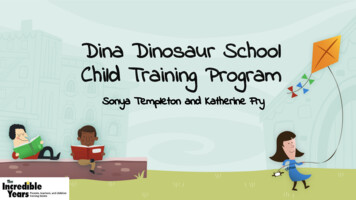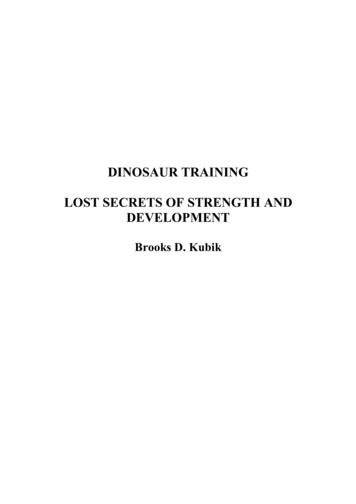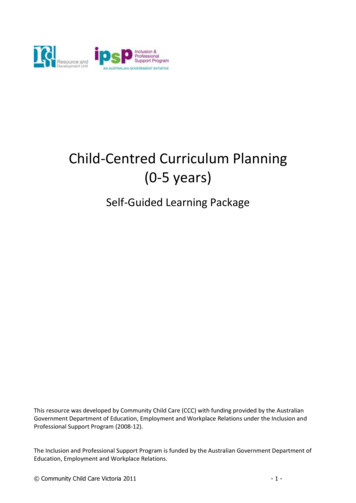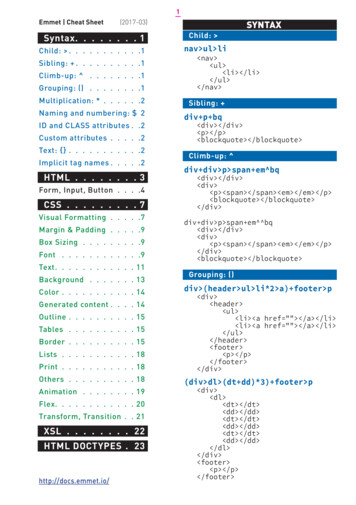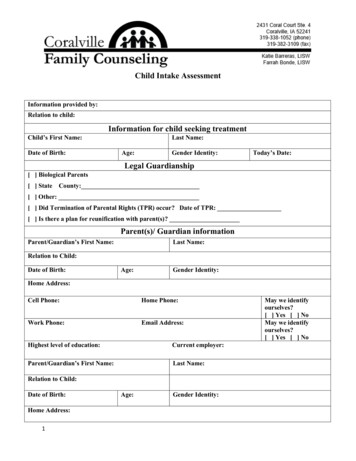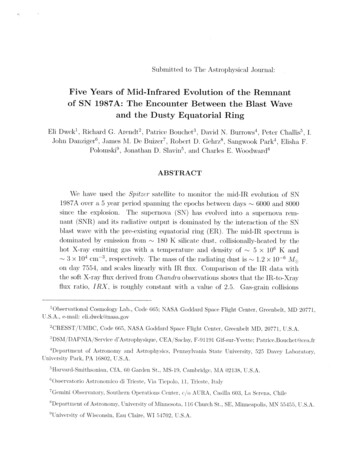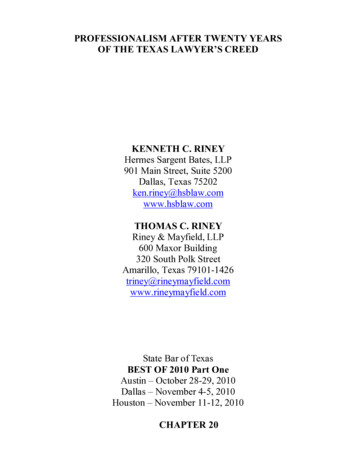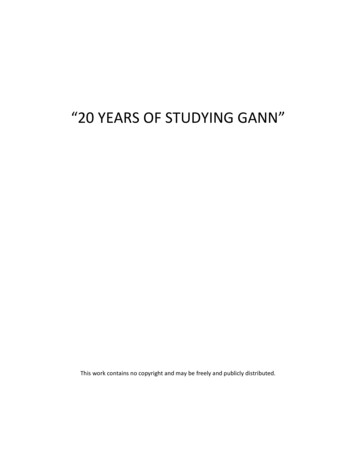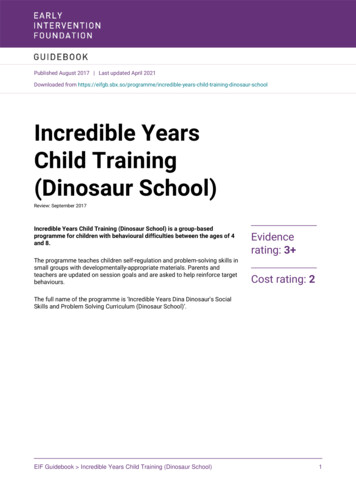
Transcription
Published August 2017 Last updated April 2021Downloaded from ild-training-dinosaur-schoolIncredible YearsChild Training(Dinosaur School)Review: September 2017Incredible Years Child Training (Dinosaur School) is a group-basedprogramme for children with behavioural difficulties between the ages of 4and 8.The programme teaches children self-regulation and problem-solving skills insmall groups with developmentally-appropriate materials. Parents andteachers are updated on session goals and are asked to help reinforce targetbehaviours.Evidencerating: 3 Cost rating: 2The full name of the programme is ‘Incredible Years Dina Dinosaur's SocialSkills and Problem Solving Curriculum (Dinosaur School)’.EIF Guidebook Incredible Years Child Training (Dinosaur School)1
EIF Programme AssessmentIncredible Years Child Training (Dinosaur School) has evidence of ashort-term positive impact on child outcomes from at least one rigorousevaluation.Evidencerating: 3 What does the evidence rating mean?Level 3 indicates evidence of efficacy. This means the programme can bedescribed as evidence-based: it has evidence from at least one rigorouslyconducted RCT or QED demonstrating a statistically significant positiveimpact on at least one child outcome.This programme does not receive a rating of 4 as it has not yet replicated itsresults in another rigorously conducted study, where at least one studyindicates long-term impacts, and at least one uses measures independent ofstudy participants.What does the plus mean?The plus rating indicates that this programme has evidence from at least onelevel 3 study, along with evidence from other studies rated 2 or better.Cost ratingA rating of 2 indicates that a programme has a medium-low cost to set up anddeliver, compared with other interventions reviewed by EIF. This is equivalentto an estimated unit cost of 100– 499.EIF Guidebook Incredible Years Child Training (Dinosaur School)Cost rating: 22
Child outcomesAccording to the best available evidence for this programme's impact, it canachieve the following positive outcomes for children:Supporting children's mental health and wellbeingImproved social problem solvingBased on study 11.56-point improvement on the Wally Child Social Problem-Solving DetectiveGame (object acquisition categories: number of different positive solutions)Improvement index: 36This means we would expect the average participant in the comparison group who did not receivethe intervention (ie, someone for whom 50% of their peers have better outcomes and 50% haveworse outcomes), to improve to the point where they would have better outcomes than 86% andworse outcomes than 14% of their peers, if they had received the intervention.Immediately after the intervention0.8-point improvement on the Wally Child Social Problem-Solving DetectiveGameImprovement index: 29This means we would expect the average participant in the comparison group who did not receivethe intervention (ie, someone for whom 50% of their peers have better outcomes and 50% haveworse outcomes), to improve to the point where they would have better outcomes than 79% andworse outcomes than 21% of their peers, if they had received the intervention.Immediately after the intervention0.16-point improvement on the Wally Child Social Problem-Solving DetectiveGameImprovement index: 27This means we would expect the average participant in the comparison group who did not receivethe intervention (ie, someone for whom 50% of their peers have better outcomes and 50% haveworse outcomes), to improve to the point where they would have better outcomes than 77% andworse outcomes than 23% of their peers, if they had received the intervention.Immediately after the interventionImproved peer interactionsEIF Guidebook Incredible Years Child Training (Dinosaur School)3
Based on study 14.5-point improvement on the Peer Problem-Solving-InteractionCommunication-Affect Rating Coding System (total negative conflictmanagement)Improvement index: 26This means we would expect the average participant in the comparison group who did not receivethe intervention (ie, someone for whom 50% of their peers have better outcomes and 50% haveworse outcomes), to improve to the point where they would have better outcomes than 76% andworse outcomes than 24% of their peers, if they had received the intervention.Immediately after the intervention0.27-point improvement on the Peer Problem-Solving-InteractionCommunication-Affect Rating Coding System (ratio of positive conflictmanagement to negative)Improvement index: 33This means we would expect the average participant in the comparison group who did not receivethe intervention (ie, someone for whom 50% of their peers have better outcomes and 50% haveworse outcomes), to improve to the point where they would have better outcomes than 83% andworse outcomes than 17% of their peers, if they had received the intervention.Immediately after the interventionImproved social competence with peersBased on study 2a5.89-point improvement on a child social competence with peers compositescore (including the Teacher Assessment of Social Behaviour measure, theSocial Health Profile, and the Dyadic Peer Interaction Scale)Improvement index: 14This means we would expect the average participant in the comparison group who did not receivethe intervention (ie, someone for whom 50% of their peers have better outcomes and 50% haveworse outcomes), to improve to the point where they would have better outcomes than 64% andworse outcomes than 36% of their peers, if they had received the intervention.Immediately after the interventionBased on study 2bPreventing crime, violence and antisocial behaviourEIF Guidebook Incredible Years Child Training (Dinosaur School)4
Improved child behaviourBased on study 133.87-point improvement on the Eyberg Child Behaviour Inventory (Intensityscale)Improvement index: 41This means we would expect the average participant in the comparison group who did not receivethe intervention (ie, someone for whom 50% of their peers have better outcomes and 50% haveworse outcomes), to improve to the point where they would have better outcomes than 91% andworse outcomes than 9% of their peers, if they had received the intervention.Immediately after the interventionReduced stress resulting from child behaviourBased on study 110.97-point improvement on the Parent Stress Index (Child Domain Score)Improvement index: 19This means we would expect the average participant in the comparison group who did not receivethe intervention (ie, someone for whom 50% of their peers have better outcomes and 50% haveworse outcomes), to improve to the point where they would have better outcomes than 69% andworse outcomes than 31% of their peers, if they had received the intervention.Immediately after the interventionReduced negative behavioursBased on study 13.15-point improvement Parent Daily Report (Number of Target NegativeBehaviours)Improvement index: 40This means we would expect the average participant in the comparison group who did not receivethe intervention (ie, someone for whom 50% of their peers have better outcomes and 50% haveworse outcomes), to improve to the point where they would have better outcomes than 90% andworse outcomes than 10% of their peers, if they had received the intervention.Immediately after the interventionEIF Guidebook Incredible Years Child Training (Dinosaur School)5
1.5-point improvement on the Parent Daily Report (Number of negativebehaviours per 24 hours)Improvement index: 23This means we would expect the average participant in the comparison group who did not receivethe intervention (ie, someone for whom 50% of their peers have better outcomes and 50% haveworse outcomes), to improve to the point where they would have better outcomes than 73% andworse outcomes than 27% of their peers, if they had received the intervention.Immediately after the interventionImproved positive behavioursBased on study 12.07-point improvement on the Parent Daily Report (Number of Target PositiveBehaviours)Improvement index: 22This means we would expect the average participant in the comparison group who did not receivethe intervention (ie, someone for whom 50% of their peers have better outcomes and 50% haveworse outcomes), to improve to the point where they would have better outcomes than 72% andworse outcomes than 28% of their peers, if they had received the intervention.Immediately after the intervention2.15-point improvement on the Parent Daily Report (Number of positivebehaviours per 24 hours)Improvement index: 26This means we would expect the average participant in the comparison group who did not receivethe intervention (ie, someone for whom 50% of their peers have better outcomes and 50% haveworse outcomes), to improve to the point where they would have better outcomes than 76% andworse outcomes than 24% of their peers, if they had received the intervention.Immediately after the interventionImproved behaviour at homeBased on study 2aEIF Guidebook Incredible Years Child Training (Dinosaur School)6
7.09-point improvement on a child conduct problems at home compositescore (including the Eyberg Child Behaviour Inventory, the Coders ImpressionsInventory for Children, and the Dyadic Parent-Child Interaction Coding System)Improvement index: 16This means we would expect the average participant in the comparison group who did not receivethe intervention (ie, someone for whom 50% of their peers have better outcomes and 50% haveworse outcomes), to improve to the point where they would have better outcomes than 66% andworse outcomes than 34% of their peers, if they had received the intervention.Immediately after the interventionBased on study 2bImproved behaviour at schoolBased on study 2a7.32-point improvement on a child conduct problems at school compositescore (including the Teacher Assessment of Social Behaviour scale, and theMOOSES classroom observation coding system)Improvement index: 16This means we would expect the average participant in the comparison group who did not receivethe intervention (ie, someone for whom 50% of their peers have better outcomes and 50% haveworse outcomes), to improve to the point where they would have better outcomes than 66% andworse outcomes than 34% of their peers, if they had received the intervention.Immediately after the interventionBased on study 2bThis programme also has evidence of supporting positive outcomes forcouples, parents or families that may be relevant to a commissioning decision.Please see the 'About the evidence' section for more detail.EIF Guidebook Incredible Years Child Training (Dinosaur School)7
Key programme characteristicsWho is it for?The best available evidence for this programme relates to the followingage-groups:PreschoolHow is it delivered?The best available evidence for this programme relates to implementationthrough these delivery models:GroupWhere is it delivered?The best available evidence for this programme relates to its implementation inthese settings:Out-patient health settingThe programme may also be delivered in these settings:Children's centre or early-years settingPrimary schoolIn-patient health settingHow is it targeted?The best available evidence for this programme relates to its implementation as:Targeted indicatedEIF Guidebook Incredible Years Child Training (Dinosaur School)8
Where has it been implemented?Denmark, Norway, United Kingdom, United StatesUK provisionThis programme has been implemented in the UK.UK evaluationThis programme’s best evidence does not include evaluation conducted in theUK.EIF Guidebook Incredible Years Child Training (Dinosaur School)9
About the programmeWhat happens during delivery?How is it delivered?Incredible Years Child Training (Dinosaur School) is delivered in 18-20sessions of 2 hours’ duration each by 2 practitioners to groups of around6 children.What happens during the intervention?The sessions include coached play, puppet interactions, video vignettes,games, activities, and circle time. Children receive ‘chips’ for positivebehaviours that are tailored to each child’s treatment goals.Children are given weekly homework assignments to complete with theirparents. Parents are also updated regularly on session goals (in personalmeetings or letters or phone calls) and given suggestions for specificbehaviours to praise and reward at home.Teachers are updated regularly on session goals (through behaviourplanning conferences, letters or phone calls) and invited to participate inbehaviour planning.What are the implementation requirements?Who can deliver it?The practitioners who delivers this programme are two therapists,counsellors, psychologists, school psychologists, or teachers, one withQCF-7/8 and one with QCF-6 level qualifications.What are the training requirements?The practitioners receive 18 hours of programme training.Booster training of practitioners is recommended.EIF Guidebook Incredible Years Child Training (Dinosaur School)10
How are the practitioners supervised?It is recommended that practitioners are supervised by 1 programmedeveloper supervisors qualified to QCF-7/8 level.What are the systems for maintaining fidelity?Programme fidelity is maintained through the following processes:Training ManualOther printed materialVideo or DVD trainingFace-to-face trainingFidelity monitoringReview of therapy sessions via videoSkype consultationIs there a licensing requirement?There is no licence required to run this programme.How does it work? (Theory of Change)How does it work?Strong emotion-regulation and problem-solving skills help children tocope with peer conflict, reduce aggressive responses, increase prosocialresponses and be academically ready to learn.Ability to identify and recognize emotions in self and others helps childrento develop emotional literacy, to problem solve and to understand andrespond appropriately to social inte
Incredible Years Child Training (Dinosaur School) is a group-based programme for children with behavioural difficulties between the ages of 4 and 8. The programme teaches children self-regulation and problem-solving skills in small groups with developmentally-appropriate materials. Parents and teachers are updated on session goals and are asked to help reinforce target behaviours. The full .
